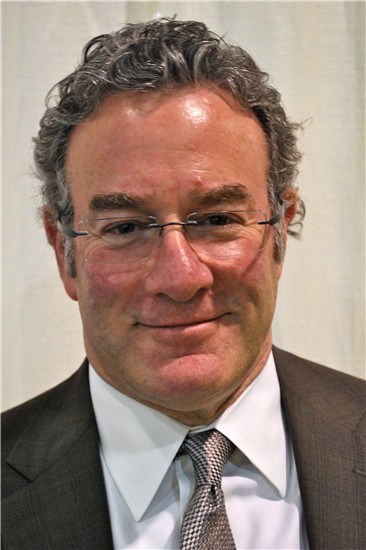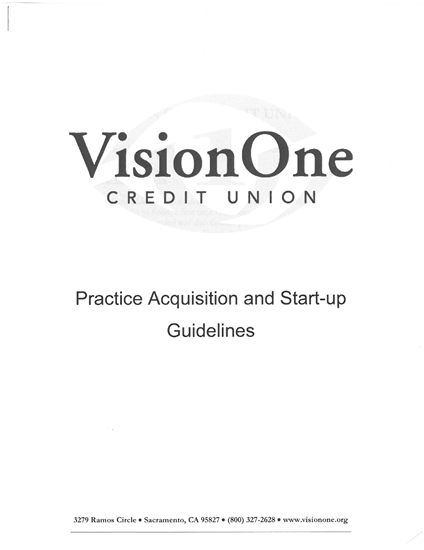Stage 2: Building Wealth
 The clock keeps ticking…we need to prepare for the next step
The clock keeps ticking…we need to prepare for the next step
By Bob Schultz
President and CEO
Vision One Credit Union
Congratulations on having purchased an optometric practice, either in whole or in part. You are following your plan for your optometric career to grow and prosper. Now your game plan must change to meet the next set of challenges.
Welcome to the second phase of optometric practice: the business of wealth-building. We dealt with the first stage–taking the first steps to practice ownership, in our last issue (click here to see the article). Next month, we will be looking at the third stage, planning to transition out of practice, by selling your practice the right way–while it still has value.
There are no hard and fast rules on when to turn your efforts to wealth-building, but by about the third year of practice ownership the thought process changes. Three years into ownership you should understand the stability and flow of patients through your practice and their impact on practice cash flow. This is the time to think about what it takes to ramp up. Begin to create a plan to grow the practice focusing on a few key guiding principles.
YEAR THREE OF PRACTICE OWNERSHIP
Guiding Principles for Growth
-
Set financial goals for yourself and your practice.
-
Define the changes needed to grow your practice and develop a plan.
-
Determine whether you can afford the changes (factor in the effect of revenues, expenses and debt service on cash flow)?
-
Calculate how the changes affect practice value now and over time?
Set Financial Goals
Financial goals should be established independent of your current situation. What have you dreamed of? Practice cash flow that will allow you to take a salary of more than $150,000, a practice value of more than $1 million or retirement at 60? It’s your dream, you set the goals.
Plan Development
Start with a clear understanding of the current position of your practice. Determine the net cash flow and a ballpark value. Most practices sell for roughly twice net cash flow assuming they are reasonably up to date, presentable and have positive trends. Determine the amount of incremental cash flow and value required to meet your goals. Factor in organic growth trends over your time horizon. The remaining gap will help you determine the extent and nature of the needed practice investment. There are a few good optometric practice consultants who can help you create and implement a Practice Development Plan.
Practice Investments
Here are some practice changes and investments for consideration:
Operations
-
Staffing changes, hiring a business manager, optimize or increase OD days, etc.
-
Adjust open hours to meet needs of your community
-
Billing, coding and collection education and efficiency
-
Increase average patient revenue through new services and modalities.
-
Increase patient volume and create new marketing plans.
Practice Investments
-
Ophthalmic equipment
-
Practice remodel, expansion or relocation
-
Second practice purchase or startup
-
Practice real estate purchase
-
Partnership
Practice Investment Decision Points
Each type of practice investment has different financial and timing requirements to realize maximum value. Changes to operations can be learned and implemented fairly quickly. They should be measured periodically to make sure they are on track to meet goals.
Equipment can be viewed as replacement, exam-enhancing, revenue-enhancing and/or just plain fun. Make sure you understand why you are buying the equipment and the impact it will have on your practice. Equipment purchase, remodel, expansion or relocation of the practice in many cases has an immediate impact on revenue and net cash flow.
-
Second practice purchases often times generate break-even net cash flow if an associate is required to staff 100 percent of the OD days and the acquisition is fully financed.Value can be created over time through growth and debt payoff.
-
Start-ups usually generate negative cash flow for one to three years before turning positive and can cost between $250,000 and $400,000.
-
Real estate generally requires a 15- to 20-year time frame to realize value through debt reduction and potential appreciation.
-
Remodeling a practice often times can increase revenue by up to 15 percent.
-
Lease-versus-mortgage payments must be reviewed to determine the affect on practice cash flow.
Partnerships can provide OD coverage, new specialties, capacity to see more patients and opportunities to consolidate locations (if the partner has an established practice). Partnerships may be discussed in subsequent articles.
Practice Valuation: Net Cash Flow Is the Key
Practice appraisers use net cash flow as a basis for practice valuations. Therefore, increasing practice net cash flow increases practice value. Generally three years of financial performance are reviewed for an appraisal. That means the increased cash flow you realize from any practice investment must show up in the practice financials for two or three years to create practice value. Accordingly, upgrading the practice on the eve of sale might enhance the visual appeal of the practice, but it generally won’t create significant value equal to the cost of improvement.
Resources
Wealth-Building: Practice Investment Strategies
from Vision One Credit Union
Click here to download more information in PDF format.
Vision One Credit Union was founded in 1951 by optometrists as a credit union for optometrists. Originally a California-based institution, service was expanded nationwide in 2004. VSP and Essilor funded $30 million into “Vision Loans,” a venture with Vision One Credit Union. The funds are loaned in creative ways to first time practice buyers to further the survival of independent optometry.
Paying for Your Practice Investments
Operational changes in the practice are usually paid for out of practice cash flow and generally do not represent a major capital outlay. The practice investments described above are costly, and outside financing is usually needed. Debt service must be factored into your overall cash flow analysis to make sure the increased cash flow created from the investment can at least meet the debt service requirements. Over time, as the debt is paid off, the debt service amount becomes available cash flow. This should continue as long as the investment property has not exceeded its useful life, which should be reviewed as part of your analysis.
Consolidating Debt Might Help
It is difficult to take on additional practice debt service when you are paying off practice acquisition debt. However, if you have a solid plan to improve the practice and have substantially paid down your acquisition debt, you might look to roll the remaining existing debt into a new loan with additional funding for your improvement plan.
Loan term is more important than interest rate when determining loan payments. Make sure you receive an appropriate term based on your cash-flow needs. Beware of financial leases for equipment or other practice investments as they generally penalize for early payments or refinancing. This may not be disclosed in the lease contract as the payoff could call for the “sum of the remaining payments,” which includes all of the interest, regardless of whether you payoff early.
Resources
 Vision One Credit Unionwas founded in 1951 by optometrists as a credit union for optometrists. As a California-based institution, service was expanded nationwide in 2004. VSP and Essilor funded $30 million into “Vision Loans” a venture with Vision One Credit Union. The funds are loaned in creative ways to first time practice buyers to further the survival of independent optometry.
Vision One Credit Unionwas founded in 1951 by optometrists as a credit union for optometrists. As a California-based institution, service was expanded nationwide in 2004. VSP and Essilor funded $30 million into “Vision Loans” a venture with Vision One Credit Union. The funds are loaned in creative ways to first time practice buyers to further the survival of independent optometry.
The Vision One Credit Union Practice Acquisition and Start-Up Guide
This guide is available atwww.visionone.org/home/education





















